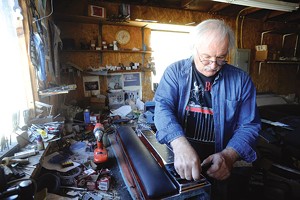Published April 10, 2013 at 7:42 a.m.
“This is a horrible little shop,” Jerry Fessenden says as he opens the door to a shack abutting the muddy driveway of his rural Montpelier home. Inside, exposed insulation stuffed between ceiling beams holds in what little warmth a small space heater against a far wall can crank out. Dusty scraps of Formica are stacked precariously on a makeshift table. The walls are decorated with grainy, computer-printed pictures, notes and phone numbers scribbled in pen directly on the plywood, and a faded banner that reads “Fessenden Guitars.” The calendar hanging above a workbench littered with metal pins, clamps and hand tools says 2007.
“I guess I haven’t changed that in a while,” says Fessenden, who, clad head to toe in denim and sporting a white handlebar mustache above an uneasy grin, bears an uncanny resemblance to David Crosby.
The small and cluttered shop isn’t “horrible,” just humble. Yet from this shack, down a dirt road off Route 2 overlooking the Montpelier Gun Club shooting range, Fessenden’s one-man operation, Fessenden Guitar Company, has supplied hundreds of pedal steel guitars to players all over the world.
His clients range from hobbyists to famous players such as Kaki King, Terry Crisp, Robert Randolph and Roosevelt Collier. His guitars have graced stages great and small, from Burlington’s tiny Radio Bean to the Super Bowl to the hallowed halls of the Grand Ole Opry.
Fessenden, 69, grew up in Hampden, Me., and says he developed his musical skills as a teenager playing in bars along Exchange Street in nearby Bangor.
“Bangor has some really fine, world-class players,” he says with a faint Down East lilt. “It was an amazing place for a musician to be.”
After he left Maine in his twenties, Fessenden bounced around New England. He eventually landed at Dekley Guitars in Enfield, Conn., where he learned both to build and play pedal steel from Jim Smith, a pioneering figure in the close-knit pedal steel community. Later, in Nashville, Fessenden worked for Sho-Bud, one of the premier pedal steel manufacturers in the country at the time. A stint in the Southeast in the 1970s found him working closely at ZB Guitars with owner Tom Brumley, best known as the steel player for Buck Owens and Ricky Nelson.
Fessenden returned to the Northeast in the late ’80s and began building his own pedal steel guitars under the Fessenden Guitar Company banner — possibly the dilapidated one still hanging in his shop. He moved to Montpelier in 1995. Despite the experience he had accrued working in pedal steel shops around the country, he says his first models were pretty crude.
“They had some problems,” Fessenden admits with typical Yankee dryness. “And people usually object to that.”
Over the years, he has ironed out those flaws. Fessenden now produces 25 to 30 guitars per year on average, ranging from a $600 “six-shooter” — a simplified six-string model that’s more portable and easier to play than standard pedal steels — to 12-string and double-necked models that cost between $2500 and $3500. Fessenden says that, when he has all the parts on hand — he farms out some work to machine shops around the country — he can build a guitar from start to finish in two or three days.
“I did 54 one year,” he says. “But working at that speed is too much.”
Fessenden sources most of his parts in the U.S. But anything with chrome — tuning pegs, for example — he reluctantly buys overseas. He says restrictions on chrome manufacturing imposed by the Environmental Protection Agency have made buying the material in America cost prohibitive.
“That really bothers me,” he says. “But that’s just the way it is.”
Fessenden is a reserved man who speaks cautiously, at least to strangers. He avoids questions about his personal life, but he loosens up when talking about music. He says he spends time every month in Nashville, where he records with various session players. He frequents the Grand Ole Opry and has pictures on his shop walls of himself and friends posing with country stars such as Charley Pride and Carrie Underwood.
“I could tell you a lot of stories about these folks,” he says of the photos. “Though I’m not sure how many of them you could print.”
Fessenden connects with the local pedal steel community through musicians such as Burlington’s Brett Lanier, who called him “a great dude” in a recent phone interview. Lanier, 29, has known Fessenden since 2005, when he was a novice player trying to find other locals with experience. Pedal steel is a niche instrument, with only a handful of players in Vermont. Lanier says he found Fessenden online, cold-called him and asked to visit. They’ve been friends ever since.
“Brett is becoming a very good steel player,” Fessenden says. “I tell him all the time he belongs in Nashville.”
Lanier is a fixture at Radio Bean’s Honky Tonk Tuesday and plays with several local artists, including Maryse Smith and Bob Wagner. While Fessenden hasn’t given him lessons in a traditional sense, Lanier says, he’s learned a lot by simply being around the man, traveling with him to pedal steel shows around the country and peeking over his shoulder at the shop.
“He’s a secret genius,” says Lanier. “He has something that he does so well and knows so much about. But at the same time, he’s really easygoing and easy to talk to.”
Specifically, Lanier says Fessenden educated him on the mechanics of the pedal steel. Given how complicated it is, a mechanical understanding of the instrument is crucial for pedal steel players.
“Jerry really understands all the different kinds of changer mechanisms, which are the brains behind the string pulling,” Lanier says.
String pulling is the essence of pedal steel guitar playing, the action that gives the instrument its signature shimmering sound. Foot pedals and knee levers are attached to rods, which connect to mechanisms that hold the strings. When the pedals and levers are activated, the tension in corresponding strings changes, raising or lowering the pitch and tuning.
One of Fessenden’s key innovations is a “clipless rod puller,” a device he has patented and sells to other builders that streamlines the Rube Goldberg-esque inner workings of the instrument.
“You need to be kind of a dweeb to play the pedal steel guitar,” says Jim Pitman in a phone conversation. “You have to be part mechanic and part musician.”
Pitman is a well-regarded pedal steel and Dobro player, best known for his work with central Vermont bands the Stone Cold Roosters and Abby Jenne and the Enablers. He’s known Fessenden since the early 1980s and used to build pickups for his guitars. Pitman also helped design Fessenden’s fretboard and the company logo, which is a silhouette of a longhorn steer head.
Pitman says he’s owned several different brands of pedal steel guitar over the years, including a few Fessenden models.
“I have to say, his 12-stringed guitars, and probably his double-neck as well, are some of the best-toned instruments around,” Pitman says. “They sound great and have lots of sustain.”
Pitman explains that pedal steel guitar is one of the few instruments whose tuning can be tempered nearly to perfection while it’s being played.
“You can’t do that with, say, a piano,” Pitman says. “The third in this key is not the third in that key. But because things are pedaled, you can tune the pitch of the pedal change, and that’s preserved for the chord that’s being played on the neck.”
When pressed to explain why his guitars have such pure tone, Fessenden confesses he’s not sure.
“I couldn’t really tell you,” he says. “They just seem to work.”
It’s hard to believe he has no answer, given his vast experience and the fact that, as Lanier is quick to point out, makers around the country often send their guitars to Fessenden for repairs when they’re stumped. Maybe Fessenden is just playing coy. Or maybe there’s a touch of magic to the pedal steel guitar itself that eludes even brilliant mechanical minds like his.
“Pedal steel players stress about tone to an almost ridiculous point. And that aspect of pedal steel guitars is hard to pin down, scientifically,” Pitman says. “It’s almost like trial and error. But somehow [Fessenden]’s landed on something.
“Jerry is kind of a maker good old boy,” Pitman continues. “Oh, and he really looks like David Crosby.”
The original print story was headlined “Pulling Strings: The ‘Secret Genius’ of Pedal Steel Guitar Builder Jerry Fessenden”
More By This Author
Speaking of Music, musician Profile
-

Two Local Band Directors March in the Macy's Parade
Nov 22, 2023 -

Before a Burlington Show, the Wood Brothers Get Back to Basics
Oct 26, 2023 -

After a Half-Century of Leading Local Ensembles, Steven and Kathy Light Prepare a Musical Farewell
May 3, 2023 -

Double E 2023 Summer Concert Series Kicks Off With the Wailers
Mar 17, 2023 -

UVM’s New School of the Arts Gathers Many Creative Disciplines Under One Roof
Sep 14, 2022 - More »
Comments
Comments are closed.
From 2014-2020, Seven Days allowed readers to comment on all stories posted on our website. While we've appreciated the suggestions and insights, right now Seven Days is prioritizing our core mission — producing high-quality, responsible local journalism — over moderating online debates between readers.
To criticize, correct or praise our reporting, please send us a letter to the editor or send us a tip. We’ll check it out and report the results.
Online comments may return when we have better tech tools for managing them. Thanks for reading.















































